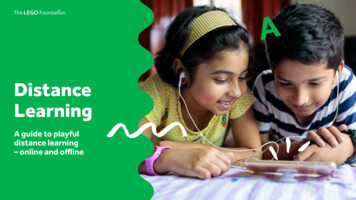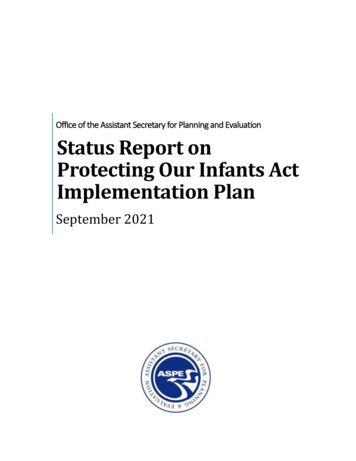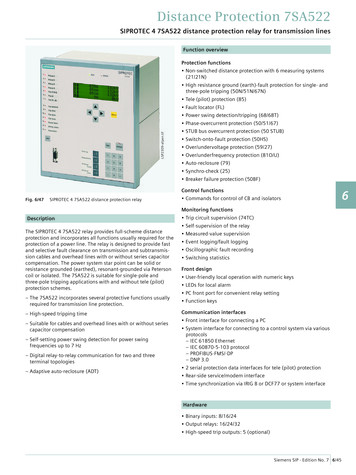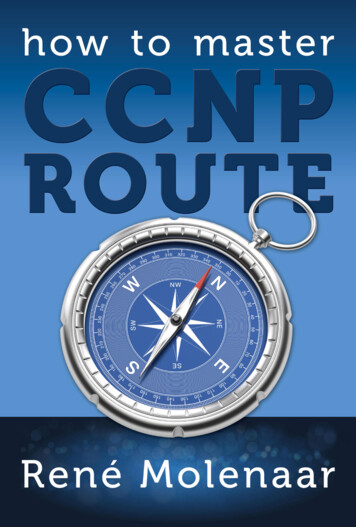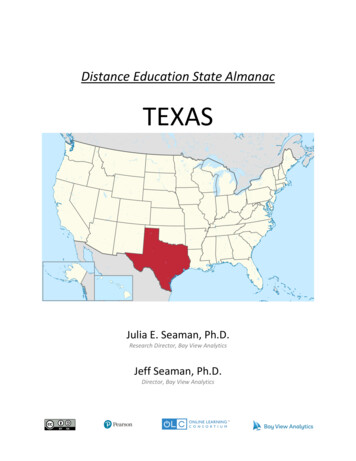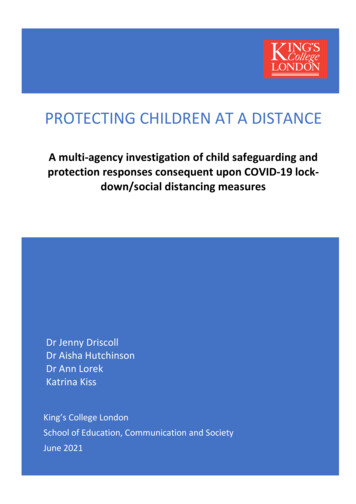
Transcription
PROTECTING CHILDREN AT A DISTANCEA multi-agency investigation of child safeguarding andprotection responses consequent upon COVID-19 lockdown/social distancing measuresDr Jenny DriscollDr Aisha HutchinsonDr Ann LorekKatrina KissKing’s College LondonSchool of Education, Communication and SocietyJune 2021
PROTECTING CHILDREN AT A DISTANCETable of Contents:Study team and acknowledgements . 6Summary . 71. Introduction.232. Multi-agency working .312.1 Safeguarding Partnerships . 312.2 Broader joint working arrangements .382.3 Representation on Safeguarding Partnerships . 422.4 Consulting Safeguarding Partnerships on changes made during the pandemic .462.5 Revised risk assessments . 482.6 Scrutiny/sharing of data/trends . 522.7 Voice of the child .542.8 The role of schools .572.8.1 School attendance . 602.8.2 Elective Home Education . 642.8.3 The burden on schools . 652.8.4 Provision of support for children and families where children are not inschool. . 682.8.5 Specialist support in (or through) schools . 713. Professional Practice .743.1 Communication and engagement with children and families . 743.1.1 Use of different modes of communication . 753.1.2 Concerns about remote communication . 783.1.3 Benefits of remote communication . 793.1.4 Access to critical IT resources .813.2 Remote operation of child protection processes and procedures . 833.2.1 Attendance and engagement .833.2.2 Efficient use of time . 843.2.3 Access challenges . 843.2.4 Acceptance of remote access by parents/carers and children . 863.2.5 Balance of advantages and disadvantages of remote communication.873.2.6 Use of hybrid meeting formats . 883.2.7 Mode of delivery adopted for case conferences . 893.3 Redeployment . 913.4 Workforce capacity and wellbeing . 943.4.1 Impact on wellbeing . 953.4.2 Strategies to address staff wellbeing . 993.5 Safeguarding related training .1014. Service Provision.1054.1 Complexity and severity of cases .1054.2 Early Help .1094.3 Children’s centres .1134.4 Case planning .1161
PROTECTING CHILDREN AT A DISTANCE4.5 Mental Health practice .1174.5.1 Increased safeguarding risks as a result of changes in mental healthservice delivery .1174.5.2 Importance of actions by mental health services and practitioners inprotecting children/young people during the pandemic .1184.6 Looked After Children .1204.6.1 Placements .1214.6.2 Professional work with Looked After Children and carers .1234.6.3 Care leavers .1255. Conclusions and Reflections .1275.1 Introduction .1275.2 Hearing the voice of the child .1285.3 Remote communication .1295.4 Multi-agency working .1305.5 Service provision .1315.6 Workforce wellbeing and capacity .1325.7 Concluding thoughts.1326. Recommendations .134References .138Appendix .141Appendix 1: Survey respondents’ recommendations for central government .141Appendix 2: Survey respondents’ recommendations for improved outcomes .153Appendix 3: Survey respondents’ recommendations for professional practice .164Appendix 4: Support for children’s mental health in schools .172Appendix 5: Support for disclosure in schools .177Appendix 6: Safeguarding Partnerships .181Appendix 7: RAG rating and risk assessments .190Appendix 8: Appropriateness and management of redeployment decisions .196Appendix 9: Supporting reflective safeguarding/child protection practice during thepandemic .200Appendix 10: ‘Shining example’ of creative practice adaptation .209Appendix 11: Areas of concern during the pandemic .2202
PROTECTING CHILDREN AT A DISTANCEList of Tables:Table 1.1: Interview participants (Stage 1)Table 2.1: Joint working as perceived by different agencies (strategic and operational)Table 2.2: Relationship between nature of risk assessment and perceived effectivenessTable 2.3: Strategies used to boost attendance and perceived effectivenessTable 2.4: Support for children not in schoolTable 2.5: Specialist posts in schoolsTable 2.6: Views on restoration of specialist posts in schoolsTable 3.1: Level of agreement with common concerns about remote communicationTable 3.2: Problems accessing critical IT resources for professionals and for children/familiesTable 3.3: Generally better attendance/engagement?Table 3.4: More efficient use of timeTable 3.5: Difficult to access for some practitionersTable 3.6: Difficult to access for some parents/carersTable 3.7: Generally disliked by parents/carersTable 3.8: Generally disliked by children/young peopleTable 3.9: Any advantages of remote do not outweigh the disadvantagesTable 3.10: Respondents’ view on how these events should be held after the pandemicTable 3.11: Agreement with redeploymentTable 3.12: Impact on wellbeing of practitioners with responsibility for safeguarding/childprotection during first lockdown and third lockdownTable 3.13: Strategies used to support safeguarding professions during the pandemicTable 3.14: Contingency plans to address increase in safeguarding/child protection workTable 3.15: Aspects of safeguarding training that were in the top 5 of priorities for allrelevant professionals as a result of the pandemicTable 4.1: Importance of action by mental health services and practitioners in protectingchildren/young people during the pandemicList of Figures:Figure 1.1: Pie chart showing number of respondents from each professional groupFigure 1.2: Role of Health professional respondentsFigure 1.3: Proportion of respondents who participated in the interview stageFigure 1.4: Pie chart showing responses by regionFigure 1.5: Professional groups by regionFigure 1.6: Respondents’ safeguarding experienceFigure 1.7: Involvement in local Safeguarding PartnershipFigure 2.1: Shift to tripartite leadershipFigure 2.2: The replacement of Local Safeguarding Children’s Boards and inter-agencycollaborationFigure 2.3: Strength of working relationships amongst Safeguarding Partners and relevantagenciesFigure 2.4: Strength of working relationships by agencyFigure 2.5: Joint working strategically and operationally (Safeguarding Partnerships)3
PROTECTING CHILDREN AT A DISTANCEFigure 2.6: Extending representation on the executive boardFigure 2.7 Relevant agencies’ involvement in the work of Safeguarding PartnershipsFigure 2.8: Consultation of Safeguarding Partnerships over local changesFigure 2.9: Satisfaction with consultation by agencyFigure 2.10: Approach to risk reassessment exercisesFigure 2.11: Perceived effectiveness of risk reassessment exercisesFigure 2.12: Strategies to support information-sharingFigure 2.13: Support for retention of information-sharing strategiesFigure 2.14: Hearing the voice of the childFigure 2.15A: Hearing the individual voice of the child by agencyFigure 2.15B: Hearing the voice of the child strategically by agencyFigure 2.16: Respondents to section on schools’ roleFigure 2.17: Vulnerable children’s attendance at schoolFigure 2.18: Reasons thought to contribute to non-attendance of vulnerable childrenFigure 2.19: Is Elective Home Education expected to rise?Figure 2.20: Have schools taken on more responsibility for safeguarding?Figure 2.21: Schools taking on more responsibility by agencyFigure 2.22: Feasibility of schools retaining increased involvementFigure 2.23: Feasibility of schools retaining increased involvement by agencyFigure 2.24: Effect of ‘keeping in touch’ arrangements on relationships with familiesFigure 3.1: Overall approach to communication with children and families during first andsubsequent lockdownsFigure 3.2: Attitudes regarding appropriate use of In-person, Video-link and TelephonecommunicationFigure 3.3: Perceived benefits of remote communicationFigure 3.4: Case conference mode of deliveryFigure 3.5: Change in wellbeing of safeguarding professionals over the course of thepandemicFigure 3.6: Change in wellbeing of safeguarding professionals over the course of thepandemic by agencyFigure 3.7: Mode of safeguarding before, during and after the pandemicFigure 4.1: Changes in severity of referralsFigure 4.2: Changes in complexity of referralsFigure 4.3: Practice with Child Protection PlansFigure 4.4: Effect of pandemic on Early Help servicesFigure 4.5: Were Early Help services cut for statutory services?Figure 4.6: Effectiveness of online Early Help servicesFigure 4.7: Appropriateness of closure of Children’s CentresFigure 4.8: Was physical closure of children’s centres appropriate?Figure 4.9: Appropriateness of children’s centres functioning remotelyFigure 4.10: Increased safeguarding risk as a result of changes in mental health servicesFigure 4.11: Strategies to increase placements4
PROTECTING CHILDREN AT A DISTANCEList of en and Family Court Advisory and Support ServiceChild and Adolescent Mental Health ServicesClinical Commissioning GroupChild in NeedChildren’s Social CareChildren and Young PeopleDirector for Children’s ServicesDepartment for EducationDesignated Safeguarding LeadDomestic Violence and AbuseEducation, Health and Care PlanElective Home EducationFamily Law Bar AssociationIndependent Reviewing OfficerLocal AuthorityLooked After ChildrenLocal Safeguarding Children BoardMulti-Agency Strategic HubNational Health ServiceNational Network for Designated Health ProfessionalsRed-Amber-Green (in relation to risk assessment rating)Special Educational Needs and DisabilitiesSafeguarding PartnershipUnaccompanied Asylum-Seeking ChildrenUniversal Credit5
PROTECTING CHILDREN AT A DISTANCEStudy team and acknowledgementsWe thank King’s Together and the ESRC Social Science Impact Fund for funding this studyand all our collaborators, listed below, for their invaluable advice and support.KCL project team:Dr Jenny Driscoll, Senior lecturer in Child Studies, King’s College LondonDr Aisha Hutchinson, Lecturer in Social Sciences, King’s College LondonDr Ann Lorek, Consultant Community Paediatrician, Designated Doctor (Greenwich)Professor Andrea Danese, Professor of Child & Adolescent Psychiatry, King’s College LondonProfessor Gillian Douglas, Professor of Law, Executive Dean, King’s College LondonExpert partners:Her Honour Judge Carol Atkinson, Designated Family Judge for East LondonDS Steve Clancey, the Metropolitan Police Continuous Policing Improvement Centre(Safeguarding Strand)Annie Hudson, former Strategic Director, Children’s Services, London Borough of LambethProfessor Jenny Pearce, Professor of Young People and Public Policy at the University ofBedfordshire, The Association of Safeguarding Partners representativeResearch Assistants:Elise KinnearKatrina KissPartner organisations:National Police Chief’s Council, Vulnerability, Knowledge and Practice Programme (reportingthrough the cross-government Child Safeguarding Reform Delivery Board)The Children’s SocietyThe Association of Safeguarding Partners (TASP)The Association of Child Protection Professionals (AoCPP)Expert Reference Group:Simon Bailey, Chief Constable for Norfolk Police, National Police Chiefs’ Council lead onChild ProtectionDr Peter Green, Chair National Network of Designated Health Professionals, DesignatedDoctor for Child Safeguarding, NHS Wandsworth CCGSarah Hannafin, Senior Policy Advisor, National Association of Head TeachersGwen Kennedy, Director of Nursing Leadership & Quality at NHS England & NHSImprovementProfessor Jenny Pearce, Professor of Young People and Public Policy at the University ofBedfordshire and The Association of Safeguarding Partners representativeMartin Pratt, ADCS Greater London Chair, Deputy Chief Executive & Executive DirectorSupporting People Camden, Regional representative on ADCS Council of ReferenceHannah Perry, Co-Chair of the Association of Lawyers for Children (ALC), Joint Head ofFamily at TV Edwards Solicitors LLPThe project team can be contacted at:Jenny.driscoll@kcl.ac.ukPlease visit the project page for more ing-children-at-a-distance6
PROTECTING CHILDREN AT A DISTANCESummary1 – INTRODUCTIONThis report presents key findings from a study designed in response to widespread concernsabout the operation of child safeguarding and protection arrangements consequent upon theCOVID-19 lockdown and social distancing measures. In light of the challenges to intra- andinteragency communication and the impact on joint working of actions taken by individualagencies, the study focused on safeguarding and protection practice, practitioner workingand the multiagency response to the COVID-19 pandemic. Stage 1 comprised interviews with67 safeguarding lead professionals in London: findings from these informed the constructionand response options for the second stage survey. Stage 2 comprised a national survey of thesame professional groups. Data was collected between 1st February and 8th March 2021 , atwhich time England was experiencing its third lockdown. The survey focused on the evolvingconcerns and response to the COVID-19 pandemic and lessons learnt from earlier lockdowns,in order to share emerging good practice and make recommendations on strengthening and‘future proofing’ the safeguarding system in England. 417 responses from safeguarding leadsfrom Health (155), Law (71), Education (56), Children’s Social Care (52), SafeguardingPartnerships (34), Police (30) and Mental Health (19) were analysed. Some caution needs tobe exercised in relation to the survey findings because of the balance of respondents bothbetween and within groups and small numbers in parts of the survey where not allrespondents were eligible to answer. This is taken into consideration in the report of the mainfindings from the survey stage summarised here.Ethical approval for the study was granted by the King’s College London Research EthicsCommittee [LRS-19/20-19420]. Stage 1 was deemed a service evaluation by participating NHSorganisations. The Health Research Agency (HRA) confirmed that NHS ethical approval wasnot needed for stage 2 on 13th January 2021. The study is funded by the King’s Together: Multi& Interdisciplinary Research Scheme and the Economic & Social Research Council ImpactAcceleration Accounts Social Science Impact Fund.The summary report from stage 1 is available -stage-1-findings.pdf2 – MULTI-AGENCY WORKING2-1 Interagency collaborationBecause the pandemic impacted at a time when many Safeguarding Partnerships wererelatively new, we were interested in understanding how the new structures were affectedand how Safeguarding Partnerships had managed their role under the pandemic. We tookadvantage of the opportunity to ask about how the shift from Local Safeguarding Children’s7
PROTECTING CHILDREN AT A DISTANCEBoards (LSCBs) to Safeguarding Partnerships was perceived to have affected arrangementsunder the conditions imposed by the pandemic.2.1 70% of respondents involved in the work of their local Safeguarding Partnership(n 293) agreed/agreed strongly that the shift to tripartite leadership had beenachieved/maintained during the pandemic in their local area. Although some stronglyworded qualitative comments suggest that the shift has not been a comfortable one insome areas, only 7.5% disagreed/disagreed strongly.2.2 Nearly half of respondents (49%, n 279) were neutral as to whether the replacement ofLSCBs with Safeguarding Partnerships improved inter-agency collaboration in their localarea, seemingly in line with commentary around whether a new body was the rightresponse to questions raised about the operation of LSCBs. But the remainingrespondents were more than three times as likely to agree than disagree: 12%disagreed/strongly disagreed; and 39% agreed/strongly agreed. Police, Children’s SocialCare and Safeguarding Partnerships respondents were most likely to state that theyagreed/strongly agreed.2.3 56% of respondents (n 269) considered that the strength of working relationshipsamongst Safeguarding Partners and relevant agencies improved as a result of theadaptations introduced as a result of the pandemic (described in interviews as primarilymore frequent regular meetings; proactive communication and sharing of data andinformation; a sense of a shared predicament; and less bureaucratic obstruction).a. Education respondents were most likely to disagree (39%).b. 67% (n 116) of respondents reported increased scrutiny of data and trends atSafeguarding Partnership level, with only four of the 72 respondents whocommented on retention opposing retention.2.4 Broader joint/collaborative working between individual agencies seems to have held upwell overall, with agencies more likely to report improvement than deterioration intheir joint working with other specific agencies, although with a more positive picturestrategically than operationally, as we might expect.a. Most agencies were most likely to report improvements rather than deterioration injoint working with Education, suggesting other professionals have found schools tohave responded well to the challenges of the pandemic.b. Consistently however, schools are less positive than other agencies about jointworking with other agencies in their local area and many appear to feelexcluded from information and not consulted adequately.c. There was a particular mismatch between Education (schools) and Children’s SocialCare in that Children’s Social Care tended to report that joint working with schoolswas more likely to have improved than deteriorated over the pandemic, but schoolswere much more likely to report deterioration of joint working with Children’s SocialCare than improvement.2.5 There was strong support for some form of representation of some relevant agencies(schools, CAMHS, health providers and housing) on the Executive Boards of Safeguarding8
PROTECTING CHILDREN AT A DISTANCE2.62.72.82.9Partnerships (notwithstanding the statutory accountability), likely reflecting concernsexpressed in interviews around potential loss of the wider partnership with the shift toSafeguarding Partnerships and as to whether operational input was strong enough.a. There was even stronger support for greater involvement of those agencies in thewider work of Safeguarding Partnerships – over 90% in all cases.b. The responses suggest considerable strength of feeling about the importance ofschools’ engagement in local arrangements in particular, with 94% of 304respondents agreeing that Education providers should be represented on theexecutive board and 98% supporting greater involvement in the wider work ofSafeguarding Partnerships by Education providers.c. We thought that the strength of feeling that we gleaned from the interviews as tothe absence of the representation of health providers might be a problem particularto London where the health estate is particularly fragmented, but the survey resultssuggest it is a nationwide issue. The question arises as to what the implications mightbe of the transition to Integrated Care Systems under the Health and Social CareWhite Paper Integrating Care.Although over half of respondents (n 253) reported single agency reassessments of risk(RAG rating), just under 20% reported a single shared assessment coordinated by theSafeguarding Partnership and the remainder reported some inter-agency collaboration.a. Generally, the exercise was regarded as effective, and a joint agency approachappears to be perceived as more effective than single agency (close tosignificance: (asymptomatic significance (2-sided) .055).b. Qualitative comments highlight concerns around children not known to services.Significant proportions of respondents reported a range of adaptations described by ourinterview participants to support information sharing:a. 33% (n 111) stated that the remit of the MASH or equivalent was widened toencompass consideration of more groups of children.b. 70% (n 135) reported increased sharing of data and trends within local authorityareas and increased scrutiny on data and trends at Safeguarding Partnership level.c. 47% (n 101) described increased sharing of data/trends between local authorityareas.d. Those who introduced such changes were asked if they would retain them, and over80% of the (smaller number) responding stated that they would.There was strong support (98%, no agency under 94%) for introduction of a system toenable all agencies to share pre-agreed information relating to safeguarding children (n 280).We asked how well the voice of the child could continue to be heard at strategic andindividual level during the adaptations introduced during the pandemic. Morerespondents considered that the voice of the child was less readily heard than felt thatit was more readily heard, but this was less pronounced at strategic level (47% lessreadily and 20% more readily) than individual level (59% less readily and 16% morereadily). At individual level, Children’s Social Care respondents were most optimistic bysome way (30% less readily heard and 35% more readily heard). At strategic level,9
PROTECTING CHILDREN AT A DISTANCEEducation was least optimistic by a pronounced margin (68% less readily heardcompared with 3% more readily heard).1. Ongoing evaluation as to the effectiveness of Safeguarding Partnerships incoordinating local areas’ safeguarding children services and providing strategicleadership. In particular, consideration as to how best to ensure that all relevantagencies, including schools, health providers, and mental health providers, are fullyengaged in the work of Safeguarding Partnerships in the light of the critical role playedby schools during periods of lockdown and the forthcoming Integrated Care legislation.2. Arrangements for multi-agency collaboration and cooperation for the protection ofchildren become of heightened importance during periods of lockdown: robustsafeguarding contingency plans should be prepared in advance of any future crises withfull input from Safeguarding Partnerships, including in relation to redeployment of anystaff with safeguarding responsibilities.3. Consideration to building on some of the initiatives for joint risk assessments andenhanced scrutiny and/or sharing of data and trends to enhance risk management inthe future. In particular, thought should be given to extension of the NHS ChildProtection-Information Sharing Programme to a wider range of agencies.4. Attention to processes and mechanisms through which hearing the voices of allchildren can be adequately assured in any future incidents in which universal servicesare closed, with attention to particular/special needs of children and families andbarriers such as digital poverty.2-2 Role of schools2.10 87% of respondents (n 295) felt that attendance should be mandatory for all primaryschool vulnerable children in families with low clinical risk (health 92%).2.11 85% of respondents (n 285) felt that attendance should be mandatory for all secondaryschool vulnerable children in families with low clinical risk (health 91%).2.12 The most effective strategies to increase school attendance were thought to be:a. encouragement from the Designated Safeguarding Lead or school staff known tothe family (used by 97%, 83% thought effective to some extent/significantly).b. using parental concerns about behaviour or schoolwork (use 91%, effective 68%).c. encouragement from the family’s social worker (use 87%, effective 64%).2.13 78% (n 255) thought that the number of Elective Home Education students was risingsignificantly (42%) or slightly (36%) as a result of the pandemic.2.14 80% (n 111) thought schools have taken on more responsibility for safeguarding as aresult of the pandemic; over half who agreed felt that this enhanced role should beretained but to do so would require additional investment.a. Schools were most likely to consider that it is not an appropriate role for schools oronly appropriate in circumstances where most children are not attending school.10
PROTECTING CHILDREN AT A DISTANCE2.15 A wide range of strategies were employed to keep in touch with and support childrenand families where vulnerable children were not in school, including regular contact intermtime and (to a lesser extent) holidays; food parcels; IT provision; in-person/doorstep visits; supply of books and games; follow-up of non-responsive families byChildren’s Social Care; and follow-up of non-responsive families by police liaison.a. as suggested by interviewees, these appear to have been effective in improvingrelationships with families in many instances and these improvements havegenerally been sustained to date.b. Police liaison was regarded as controversial by some interviewees but was usedby 57% of survey respondents (n 72) and the same proportion intended to use againin future if required.2.16 Varied and sometimes uncoordinated support for children’s mental health anddisclosure in/through schools was described. Learning from the pandemic may beof longer-term use as schools take on greater responsibility for work to supportchildren’s mental health.Recommendations:5. Concerted intervention by both education and safeguarding pro
PROTECTING CHILDREN AT A DISTANCE A multi-agency investigation of child safeguarding and protection responses consequent upon COVID-19 lock-down/social distancing measures Dr Jenny Driscoll Dr Aisha Hutchinson Dr Ann Lorek Katrina Kiss

